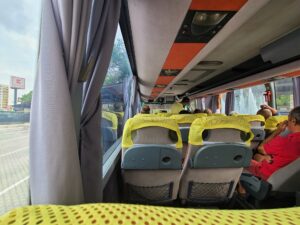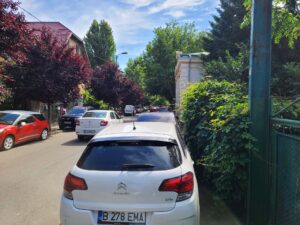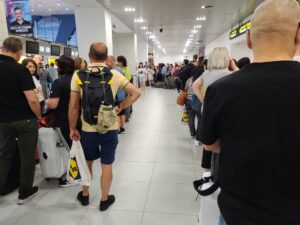Getting around Romania and navigating local transportation is a fairly simple and straightforward process. The quality of infrastructure in the country may lag behind that of most other nations in the European Union, but that doesn’t mean it’s an exceptional challenge.

In practice, transportation in Romania is a few decades behind. You will have to exercise patience and prepare for some longer-than-expected journeys. But it is generally fairly cheap.
Getting around Romania can be a little tedious, but the country is well-connected with buses and trains that are more than adequate for most tourists.
Contents
Transportation in Romania – Via Train
The Romanian rail network decently connects the major cities. It’s a noticeably slow process. A couple hundred miles often takes several hours. There are some gaps, too, and the southern half of the country (nearer to the Capital City, Bucharest) has a better network of rail lines.

The transportation gaps in trains in Romania usually mean that there will be a transfer involved. Just because two cities appear on a map as though they should have a direct rail link does not mean they do.
For instance, Iasi is one of the largest cities in Romania and is very poorly connected. Iasi is only about 200 miles from Bucharest, but taking the train between the two cities will take at least 6-7 hours (probably longer) and involves a transfer station.
It is even closer to Cluj-Napoca, another one of the largest Romanian cities, but trains on this route can take over 10 hours. That is excessive. It doesn’t help that transportation in Romania by train involves trips that stop (what seems like) every ten minutes to service (what seems like) every tiny village in the country. Connectivity is great for the small towns and rural areas, but express/nonstop options also make a ton of sense for many routes. These are few and far in between.
Additionally, Timisoara is due west of Sibiu. A highway links the significant cities, which are less than 150 miles apart in a straight line. There is, however, no direct route by train. A transfer in Arad is required, making the journey by rail over 8 hours.

While trains in Romania may not mean a fast journey, they are reliable. They are immune from traffic jams and depart/arrive close to the listed times.
Costs
Train transportation in Romania is also the cheapest way to get around the country. For example, I paid 13 Lei for a two-and-a-half hour train from Sibiu to Sighisoara, That is LESS than $3!
There are few places in Europe with trains as cheap as those in Romania. If you are traveling on a budget or backpacking through Romania, trains are your best option.
Comfort
Romanian trains are not fancy. Most of the rail stock is a few decades old, with some newer cars in the mix.
To put it lightly, the older trains are well-worn. Seats are comfortable enough. These aren’t the cleanest trains, but it’s mostly just dirty windows and a bit of grime in the cracks from years of use.
Make sure you have a seat booked on your train. On one of my journeys, there were no assigned seats. It was first come, first serve, and the corridors of the cars were packed with a standing-room-only crowd.

However, most trains in Romania designate reserved cars and seats. Pay no attention to the numbers painted on the outside of the train. The paper taped on the inside of the windows designates the car and class number.
The best website to use to find train schedules in Romania is the CFR website.
Transportation in Romania – Via Bus
The next best method of transportation for getting around Romania is via bus. Buses in Romania offer a wider network of connections and destinations but also have a few negative aspects.
Inter-city buses in Romania are far more comfortable than trains. They are newer, have more legroom, better seats and offer air-conditioning. Buses often are not as full as trains, meaning you stand a decent chance to have a row to yourself.

Bus transportation in Romania is also better connected than trains. Sometimes. Longer bus routes do not stop every 10 minutes like the trains do. However, the train stations in these small towns are often little more than train stops that can be a mile or two from the actual town. Instead, bus routes are more direct to a city/town center and serve a wider variety of cities and towns.
The primary downside to getting around Romania via bus is the price. Buses are considerably more expensive. The journey I mentioned above on the cheap train would have cost $10-12 on a bus. It’s not much, but it is 4x the price of the train. On longer routes, the price differences are more noticeable.
Buses in Romania are advertised to be faster. This is because they do not stop at every little town between City A and City B.
This is not a reliable metric.
Getting around Romania via bus can be faster, but it can also take a lot longer. Buses are subject to traffic jams. Romania’s limited infrastructure extends to the highway network.
I opted to take the bus from Bucharest to Sibiu. This is supposed to be the fastest, most direct option. In my case, it was supposed to take about 4.5 hours with a couple of cities served in between.
After 3 hours, we hit a traffic jam that lasted more than 2 hours. We then rode another hour before stopping at a rest stop for about 20 minutes. About 45 minutes later, we arrived in Sibiu. The 4.5 hour trip ended up being about 6.5 hours.
Roads are much busier around holidays and Summer weekends. Buses are a much more comfortable transportation option in Romania, but they are not reliable.
The best website to use to find a bus schedule in Romania is Autogari.
Renting a Car in Romania
Many of Romania’s most spectacular tourist attractions are not easy to reach. The transportation infrastructure in the country does a poor job of connecting more remote areas.
For tourists, reaching many of these places involves a long, tedious journey. There will be trains and buses with transfers, and you still might have to hire a car to reach a particular site.
So, why not rent a car for yourself?
Renting a car in Romania is definitely an effective and fast way to get around. You can stop when and where you want. You can visit out-of-the-way attractions with ease. And you can probably get there a lot faster.
Renting a car is not, however, a totally stress-free method of transportation in Romania. Though cheaper than in Western Europe, it is more expensive than public transportation. For Americans (probably not Californians, though), the price of gasoline in Romania is also a factor – average prices can exceed $8/gallon. Parking in cities is also a nightmare.

Personally, I am hesitant to rent a car in Romania. For one, I enjoy trains and buses. These are easy and cheap – perfect for backpackers. I also love staring out the window to enjoy the passing scenery. If I want to doze off, I close my eyes and let the train rock me to sleep.
The main reason you should exercise caution renting a car in Romania is what happens on the roads. Local drivers are absolutely nuts. Rural roads can be poorly maintained. And Google Maps in Romania sucks.
I’ll say it again: Romanian drivers are nuts. In cities, they have little regard for pedestrians. Outside of the city, they seem to have little regard for their own safety or that of others on the road. Exercise additional caution if you decide to rent a car in Romania.
Lovely people. Terrible drivers.
Transportation in Romania – Via Domestic Flight
Another transportation option for getting around Romania is to take domestic flights.
Travel times are cut significantly shorter when you can fly over all of the traffic jams, winding roads and slow-moving trains below. If your time in Romania is limited, this is an okay option.
Domestic flights in Romania are cheap. Of course, flights in Europe are generally pretty cheap. Air travel in the country is much more expensive than ground transportation, though.
The only reason I would even consider a domestic flight within Romania as a transportation option is a situation where I know exactly where I am going and time is in short supply. Otherwise, it’s not worth it.
The cost of flying in Romania is one major deterrent for me. The flights are cheap, yes; but, by the time you get an Uber to the airport and from the airport, you can easily double that price. Airport food is also much more expensive than the food around train and bus stations.

The main reason I would avoid domestic flights in Romania has to do with Bucharest OTP Airport. This place is an absolute disaster. The fact that this is the primary air connection for an entire country, a modern European country, is baffling.
OTP Airport is extremely busy. It seems to have a severe staffing shortage, and check-in times for flights are atrocious. Lines are unbelievably long for everything from check-in to food. People queue up in groups of hundreds, really just guessing, hoping they are in the right “line.”
After the additional costs to get to/from the airport and hours of waiting, it is hard for me to endorse any transportation to get around Romania that involves Bucharest OTP Airport.
I can put this another way, too. On my next trip to Romania, which I sincerely hope is sooner than later, my travel route will likely involve entering the country by rail.
Other, smaller airports in Romania may be more practical to use. Having not been to any other airport in the country, I cannot comment on that.
The Infamous Romanian Taxi
I have to mention taxis in Romania. By all accounts, tourists should avoid taxis in Romania.
Romanian cabs are notorious for scamming tourists. I cannot attest to this, personally, and I even met a couple of foreigners in the country who said they took taxis with no issues. However, the general consensus from locals is that taxis have a tendency to scam tourists.
If you have to use a taxi, agree on a price before you depart. Make it clear that the price includes all passengers riding in the vehicle. If you want extra peace of mind, record the agreement on your phone.
Most of my getting around in Romanian cities was on foot. On the few occasions I had to go a longer distance (i.e. the airport), I took an Uber. Uber in Romania is really cheap and scam-free.
Transportation in Romania is pretty easy, and there really aren’t any tricks to getting around the country. It’s a straightforward process. Buses and trains are safe and comfortable enough.

What transportation in Romania lacks in connectivity and speediness, it makes up for this in cheapness and decent reliability. The most important thing you can do is get comfortable, be patient and enjoy the ride.
Leave a Reply
You must be logged in to post a comment.